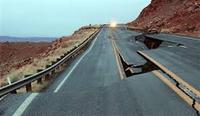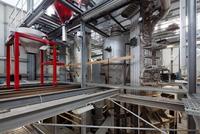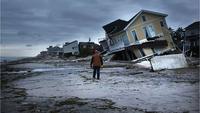-
House Intelligence Committee to work on cybersecurity bill in camera
The House Intelligence Committee will meet next week in order to draft a cybersecurity bill, known as the Cyber Intelligence Sharing and Protection Act (CISPA), but will not allow media members or the public to sit in on meetings during the process.
-
-
Obama, Hagel take pay cut to help sequester-affected federal employees

President Barack Obama is following in the footsteps of Defense Secretary Chuck Hagel by taking a 5 percent pay cut to support federal workers who will be furloughed. Obama’s move will be backdated to 1 March, the first day of the sequester. The president’s yearly salary is $400,000, meaning that the cut will equal $20,000. Other senior administration officials, and some members of Congress and their staffs, have also announced that they will return a portion of their salary to the Treasury.
-
-
Renewable energy could economically replace fossil-based energy in Australia
A carbon price of between AU$50 and AU$100 per ton of carbon dioxide would make coal-fired and gas-fired power in Australia less economical than renewable electricity. A new study says that all fossil-fuelled power stations in Australia’s National Electricity Market could be phased out and replaced economically and reliably with commercially available renewable energy technologies by increasing the carbon price to this “medium” level.
-
-
Bipartisan House immigration overhaul bill offers three paths to legal status
While a bipartisan Senate group – the Group of Eight – is set to unveil its immigration overhaul proposal next week when Congress returns from a break, a bipartisan group of House members has come up with its own immigration reform draft. The House members’ proposal divides illegal immigrants into three categories – “Dreamers” and agricultural workers; those with families and jobs in the United States; and those who do not belong in either of the two other categories – and offers immigrants in each category a distinct path to citizenship.
-
-
U.S. nuclear industry faces a wave of nuclear power station retirements
A wave of U.S. nuclear power station retirements is on the horizon. The typical design life of a nuclear power plant is 40 years. There are 104 nuclear power plants in the United States, and their average age is 34 years — only a few years short of, and fast approaching, their design life. Almost 30 U.S. commercial and research reactors already have started decommissioning. A $400 million is regarded as the bargain basement price tag for cleaning up a single reactor.
-
-
China catches 12 times more fish beyond its waters than it reports
Chinese fishing boats catch about $11.5 billion worth of fish from beyond their country’s own waters each year — and most of it goes unreported. Researchers estimate Chinese foreign fishing at 4.6 million tons per year, taken from the waters of at least ninety countries — including 3.1 million tons from African waters, mainly West Africa.
-
-
Same-day water test keeps beaches open, swimmers’ health protected

With warm summer days at the beach on the minds of millions of winter-weary people, scientists are reporting that use of a new water quality test this year could prevent unnecessary beach closures, while better protecting the health of swimmers.
-
-
Engineers educate lawmakers about aging U.S. infrastructure

Two hundred members of the American Society of Civil Engineering (ASCE) fanned out across Capitol Hill last month for the annual Legislative Fly-In with a message: U.S. infrastructure problems are solvable if we have strong leadership in Congress. The ASCE members highlighted the nation’s need to eliminate the backlog of infrastructure deficiencies, modernize roads, bridges, water systems, and energy grid – and reminded Congress that to promote commerce and protect public safety, welfare, and the environment, infrastructure investment is a priority issue.
-
-
FBI wants 1994 online surveillance law updated
The FBI said the agency’s top priority this year is to update a surveillance law so authorities can monitor in real time Web activities of Americans suspected of committing crimes. The 1994 law, known as the Communications Assistance for Law Enforcement Act (CALEA), applies to telecommunication companies, but only partially to Web-based companies.
-
-
Americans support preparation for extreme weather, coastal challenges: survey
The challenges posed by rising sea levels and increasingly severe storms will only intensify as more Americans build along the coasts. A just-released NOAA report predicts that already crowded U.S. coastlines will become home to an additional eleven million people by 2020. A Stanford survey finds that the majority of Americans support stronger coastal development codes. Among the most popular policy solutions: stronger building codes for new structures along the coast to minimize damage, and preventing new buildings from being built near the coast.
-
-
Obama promotes private-public infrastructure investment plan
President Barack Obama spent Friday afternoon at the Port of Miami where he announced his plan to attract private investment for big infrastructure projects. One such project is a $2 billion upgrading plan for the port. Obama also he would continue his push for a $100 billion infrastructure bank.
-
-
Using waste heat to capture CO2 before it goes up in smoke

Power plants fired by coal and natural gas account for about half of the CO2 that humans add to the atmosphere each year; these power plants are prime candidates for new technology that captures CO2 before it goes up in smoke. Researchers seek to optimize CO2 removal from power plant emissions by employing waste heat. This is just one example of looking to improve upon a tried-and-true technology for CO2 capture. That technology — a two-phase chemical process — has been used for decades to remove naturally occurring CO2 from natural gas.
-
-
U.S. suffered $119 billion in disaster-related losses in 2012

Natural and man-made disasters contributed to $186 billion in economic losses around the world last year. The United States took the biggest hit with $119 billion in losses. Insurance claims for weather-related losses in 2012 totaled $77 billion dollars, the third most expensive losses on record. Nine of the top ten most expensive insured loss events which occurred last year happened in the United States.
-
-
New foot-and-mouth vaccine shows promise
The 2001 foot and mouth outbreak in Britain was devastating and cost the economy billions of pounds in control measures and compensation. One recommendation in a Royal Society report following the epidemic recommended the development of new approaches to control the virus. Scientists have used a new method to produce a vaccine which does not rely on inactivating the live, infectious virus which causes the disease — and is therefore much safer to produce.
-
-
U.S. water infrastructure is in a serious state of disrepair
The U.S. water system is in a state of disrepair, and is deteriorating further every year for lack of money for maintenance and upkeep. The results include an estimated 240,000 water main breaks each year and nearly 14,000 dams — or one out of every seven dams — in the United States rated as “high hazard,” meaning that the flush of water from a broken dam would likely kill people.
-
More headlines
The long view
Factories First: Winning the Drone War Before It Starts
Wars are won by factories before they are won on the battlefield,Martin C. Feldmann writes, noting that the United States lacks the manufacturing depth for the coming drone age. Rectifying this situation “will take far more than procurement tweaks,” Feldmann writes. “It demands a national-level, wartime-scale industrial mobilization.”
Trump Is Fast-Tracking New Coal Mines — Even When They Don’t Make Economic Sense
In Appalachian Tennessee, mines shut down and couldn’t pay their debts. Now a new one is opening under the guise of an “energy emergency.”
Smaller Nuclear Reactors Spark Renewed Interest in a Once-Shunned Energy Source
In the past two years, half the states have taken action to promote nuclear power, from creating nuclear task forces to integrating nuclear into long-term energy plans.
